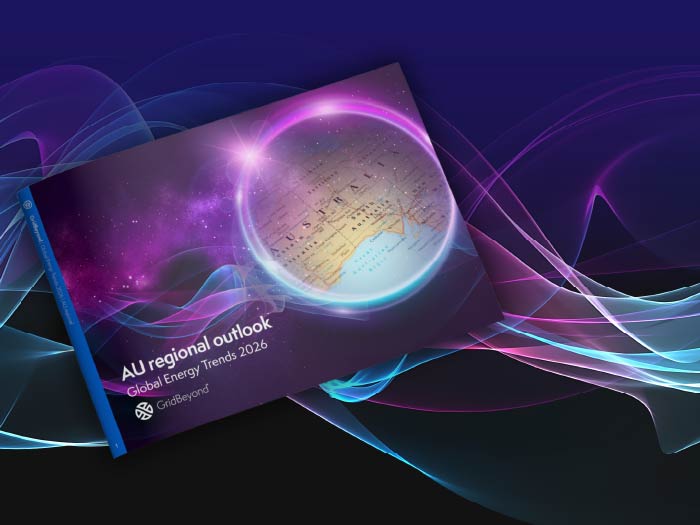News
better business decisions
Posted 2 years ago | 7 minute read
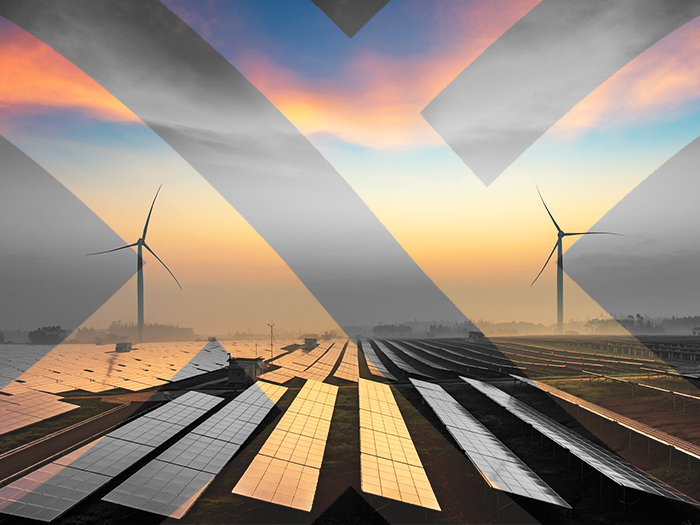
Power matching with clean energy
Large energy buyers play an important role in the clean energy transition. But they will need to go further and expand their approaches to clean energy procurement and demand flexibility.
In an era where the consequences of climate change are becoming increasingly apparent, transitioning to clean and renewable energy sources has become an imperative for sustainable development. One bold and ambitious goal that has gained momentum in recent years is the concept of matching 100% of electricity consumption with clean electricity production. This vision not only holds the potential to mitigate environmental impacts but also promises a resilient and secure energy.
Traditional methods of electricity generation, heavily reliant on fossil fuels, have left a considerable carbon footprint on our planet. Currently the average utility supplies 33% of energy as renewable using clean energy sources, such as solar, wind, hydro, and geothermal power. But these technologies come with their own set of challenges.
Unlike fossil fuels, which can be dispatched at will, renewable sources are often variable in nature. The sun doesn’t always shine, the wind doesn’t always blow, and the availability of hydroelectric power can be subject to seasonal changes. This variability poses a significant challenge in achieving the goal of 100% clean electricity consumption, as it requires a robust system that can balance supply and demand in real-time.
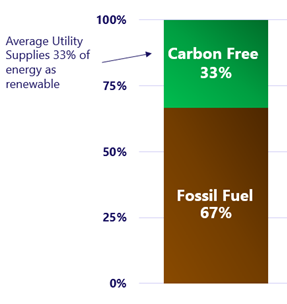
Source: GridBeyond (figures are representative for Ireland)
However, large energy buyers have the opportunity to match clean energy purchasing with the timing of their energy use, incorporating demand flexibility, purchasing dispatchable clean electricity, adopting enabling technologies (such as energy storage), maximising emissions reductions, reducing costs and driving the transition to clean energy.
The role of technology, data and analytics
Advances in technology have been pivotal in addressing the variability challenge posed by renewables. Smart grids, for instance, incorporate digital communication and control capabilities into the traditional electricity infrastructure. These grids can automatically adjust consumption and distribution based on real-time data, optimising the use of available clean energy.
Energy storage solutions, such as batteries, also play a vital role by storing excess energy during periods of high production and releasing it during lulls in production. The widespread adoption of electric vehicles (EVs) has also contributed to the growth of battery technology, with EV batteries being repurposed for grid storage during their operational downtime. Energy storage not only ensures a consistent supply of electricity but also reduces wastage of excess clean energy, maximising its utilisation. This goes some way in bridging the gap between clean energy generation and demand.
But achieving the goal of 100% clean electricity consumption takes this one step further and requires a deep understanding of energy patterns and behaviours. This is where data and analytics come into play.
With smart meters and sensors, a wealth of data is generated on electricity consumption, production, and distribution. Advanced data analytics can decipher this information to forecast energy demand, predict renewable energy generation, and optimise the operation of energy storage systems in real time. This means the vision of matching 100% of electricity consumption with clean electricity production on an hourly basis is achievable , with the right technology and purchasing strategy.
Getting to 24/7 carbon free energy
Until the power grid becomes 100% renewable there is no single way of getting to 100% carbon free energy, however there are a series of steps that a business could take to get from the average of 33% renewable grid supplied electricity up to around 83% carbon free energy.
1. Grid energy as a baseline
Grid energy, supplied by local utilities, serves as the foundation of energy consumption for most I&C users. To reduce carbon emissions, it is imperative to understand the current energy mix. Ireland’s energy mix for example it predominantly consists of fossil fuels, particularly natural gas.
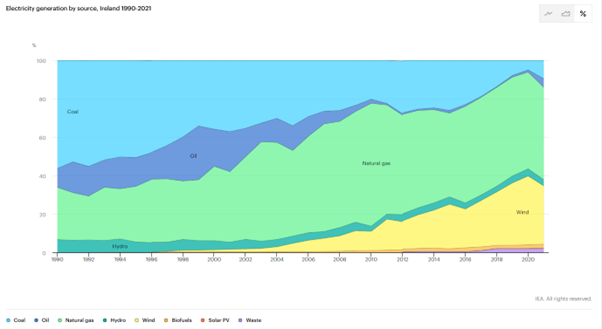
Source: IEA
One way to enhance your green energy sourcing from the grid is to participate in Renewable Energy Certificate (REC) programs or similar. RECs allow you to purchase renewable energy credits, essentially “greening” your grid energy consumption by offsetting it with renewable energy production elsewhere.
2. Solar power for daylight energy
Installing solar power is a pivotal step towards achieving carbon-free energy during daylight hours. Solar panels on your facility’s rooftop or nearby land can convert sunlight into clean electricity. To maximize the benefits of solar power, conduct a thorough feasibility study and design a system that suits your energy needs. Consider factors such as location, available space, and energy consumption patterns. Additionally, explore government incentives and tax credits for solar installations that can significantly reduce your upfront costs.
3. Corporate Power Purchase Agreements (CPPA)
Corporate Power Purchase Agreements (CPPAs) have gained popularity as a means for I&C users to procure renewable energy directly from developers or renewable energy providers. CPPAs typically involve long-term contracts, often spanning 10-20 years, ensuring a stable and affordable supply of green energy.
CPPAs can take various forms:
- Offsite CPPAs: Purchase electricity from an offsite renewable energy project, such as a wind farm or solar farm, while the energy is fed into the grid. Businesses receive the environmental benefits and often enjoy fixed or competitive energy prices.
- Onsite CPPAs: Install renewable energy systems on premises through a third-party provider, who owns and maintains the equipment, the generated energy can be bought at a predetermined rate, often below market prices.
- CPPAs offer I&C users the flexibility to customize their energy sourcing and promote the development of renewable energy projects. They also demonstrate a strong commitment to sustainability, which can enhance your company’s reputation and attract eco-conscious customers.
4. Battery storage for energy resilience
While solar power generates electricity during the day, energy needs may extend beyond daylight hours. Battery storage systems bridge this gap by storing excess solar energy for use during the night or cloudy days. Additionally, batteries provide energy resilience by acting as backup power sources during grid outages. Investing in advanced battery technologies, like lithium-ion batteries, can ensure efficient energy storage and retrieval. Proper sizing of the battery system is crucial to meet facility’s energy demands and maintain a steady supply of carbon-free energy around the clock.
5. Load management for efficiency
Efficient load management is the final piece of the puzzle for achieving 24/7 carbon-free energy. By optimising energy consumption patterns, companies can further reduce carbon footprint and energy costs. Implement energy management systems that monitor and control facility’s energy usage in real-time. These systems can automatically adjust assets such as lighting, HVAC, and other energy-intensive processes to minimise wastage and align energy consumption with the availability of solar and battery power.
Participation in demand response programs, where businesses voluntarily reduce your energy consumption during peak demand periods, also allow for generation of revenues and reduced energy rate, which can be ringfenced for further investment in net zero technologies.
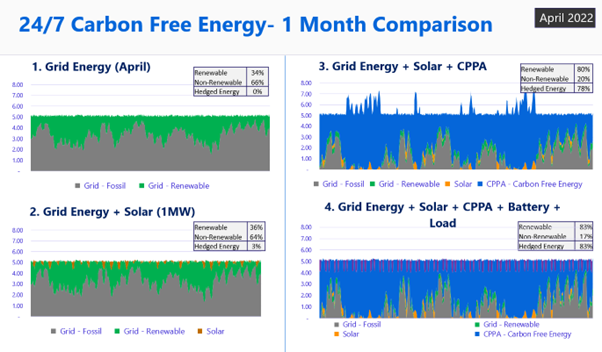
Source: GridBeyond (figures are representative of Ireland)
Conclusion
Transitioning to 24/7 carbon-free energy is not only achievable but also a strategic move for I&C energy users. By combining Grid Energy, Solar Power, Corporate Power Purchase Agreements (CPPA), Battery Storage, and Load Management, carbon emissions can significantly reduced while enhancing energy resilience and cost-effectiveness.
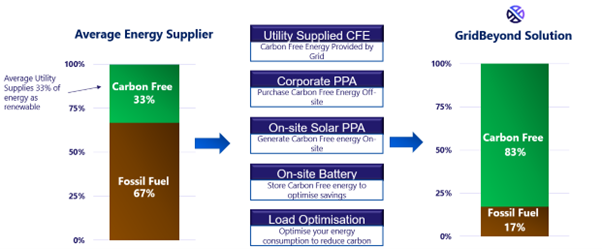
Source: GridBeyond (figures are representative of Ireland)
Each of these components plays a vital role in a holistic carbon-free energy strategy. Grid energy forms the foundation, solar power provides daytime electricity, CPPAs ensure a steady supply of renewable energy, batteries offer energy storage and resilience, and load management optimises energy consumption.
At GridBeyond, we use AI and advanced technology to change the way businesses procure and use energy. By putting control into their hands, we empower energy consumers to intelligently control and optimise their energy strategy and create new value on their side of the meter.
How? Using our technology.




